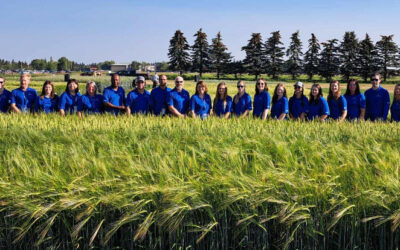With more known than ever before about the genes in plants, plant breeders are now breeding crops with less allergens in them.
Certain ingredients in foods may affect people in different ways by causing allergic reactions or making them sick. For years people have found themselves having to avoid eating foods, but that could change as plant breeders are now breeding crop varieties with less allergens in them making for new safe ingredients to eat.
“It’s a matter of defining exactly which molecule is allergenic and then to find the key gene regulating the biosynthetic pathway for this compound. Once the gene is identified it can be knocked out. There are various different techniques to do that. The best way at the moment is probably to do it by mutagenesis,” Olof Olsson, a senior advisor with ScanOats Industrial Research Center, explains during the Feb. 15 episode of Seed Speaks.
The Scan Oats team were involved in the sequencing of the oat genome. Oats are known as being one of the few cereal crops that those with celiac disease can eat. By sequencing the genome, they were able to scan the entire genome for any DNA sequences similar to previously identified encode prolamin proteins. These proteins include glutein and gliadin in wheat, hordein in barley, secalin in rye and avenin in oat. Olsson explained that in wheat there are many different classes of glutens with some being more toxic than others — causing immunogenic reactions such as celiac disease.
“When we looked at the oat avenins, the ones that would correspond to the most toxic ones in wheat, the alpha and the omega glutenins, they’re not present at all in the oat genome. But they have high molecular weight ones, which are considered less toxic, are present,” he added. “When we analysed at the remaining ones, however, we found a few epitopes in some of the genes, that are correlated to the celiac disease. However, those genes are much less expressed in oat than in wheat.”
This molecular information confirms why in most cases it’s safer for those with celiac disease to eat oats. There are some oat varieties which include even fewer of the critical epitopes, but this research now makes it possible to mutate away the more toxic genes.
“The next step will be that we start looking in wheat for the absence of these proteins and maybe enhance some of the good proteins, because you want to keep the baking properties at the same time,” Olsson said.
There are wheat varieties which are safe for those with celiac disease to eat. Sachin Rustgi, an associate professor of molecular breeding at Clemson University, along with his team, bred two wheat varieties where they targeted a master regulator of immunogenic gliadins and low molecular weight glutenins in gluten along with expressed gluten degrading enzymes, ‘glutenases’ in grains. There are about 70 to 100 gluten proteins in wheat with some being more toxic than others — the toxic ones causing the immunogenic reactions such as celiac disease.
“Research has been done and it has been demonstrated one can reduce the content of these gliadins or completely eliminate them, (and the wheat flour) will still bake into bread,” Rustgi explained during the episode.
They have been using CRISPR technology to breed these wheat varieties by removing the gliadins and low molecular weight component of glutenins. Rustgi added that they have also looked at developing barley lines with these properties.
Celiac disease and cereal varieties aren’t the only crops being looked at by plant breeders for their allergen qualities. There’s research being done to remove the allergens from soybeans, and Rustgi is involved in research to make peanuts less allergenic.
There have been four proteins identified in peanuts that are major allergens. Rustgi said they’re screening a germplasm collection. They have identified the lines that were deficient in specific allergens and are making genetic crosses to stack them. They’re also using genome editing to kill these four major allergen targets in the peanuts to produce a reduced allergenicity line.
Related Articles
What’s Your Final Goal in Breeding? It’s Not Always Obvious





